国际内部审计专业实务框架 2017版(IPPF Standards 2017)
- 格式:pdf
- 大小:351.94 KB
- 文档页数:25
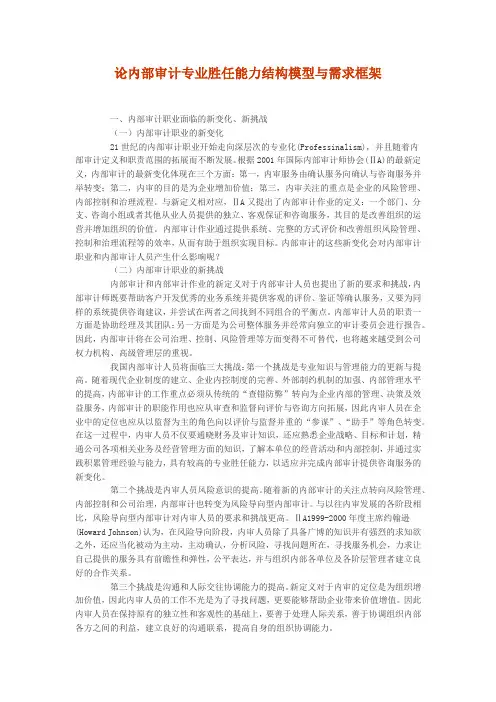
论内部审计专业胜任能力结构模型与需求框架一、内部审计职业面临的新变化、新挑战(一)内部审计职业的新变化21世纪的内部审计职业开始走向深层次的专业化(Professinalism),并且随着内部审计定义和职责范围的拓展而不断发展。
根据2001年国际内部审计师协会(ⅡA)的最新定义,内部审计的最新变化体现在三个方面:第一,内审服务由确认服务向确认与咨询服务并举转变;第二,内审的目的是为企业增加价值;第三,内审关注的重点是企业的风险管理、内部控制和治理流程。
与新定义相对应,ⅡA又提出了内部审计作业的定义:一个部门、分支、咨询小组或者其他从业人员提供的独立、客观保证和咨询服务,其目的是改善组织的运营并增加组织的价值。
内部审计作业通过提供系统、完整的方式评价和改善组织风险管理、控制和治理流程等的效率,从而有助于组织实现目标。
内部审计的这些新变化会对内部审计职业和内部审计人员产生什么影响呢?(二)内部审计职业的新挑战内部审计和内部审计作业的新定义对于内部审计人员也提出了新的要求和挑战,内部审计师既要帮助客户开发优秀的业务系统并提供客观的评价、鉴证等确认服务,又要为同样的系统提供咨询建议,并尝试在两者之间找到不同组合的平衡点。
内部审计人员的职责一方面是协助经理及其团队;另一方面是为公司整体服务并经常向独立的审计委员会进行报告。
因此,内部审计将在公司治理、控制、风险管理等方面变得不可替代,也将越来越受到公司权力机构、高级管理层的重视。
我国内部审计人员将面临三大挑战:第一个挑战是专业知识与管理能力的更新与提高。
随着现代企业制度的建立、企业内控制度的完善、外部制约机制的加强、内部管理水平的提高,内部审计的工作重点必须从传统的“查错防弊”转向为企业内部的管理、决策及效益服务,内部审计的职能作用也应从审查和监督向评价与咨询方向拓展,因此内审人员在企业中的定位也应从以监督为主的角色向以评价与监督并重的“参谋”、“助手”等角色转变。
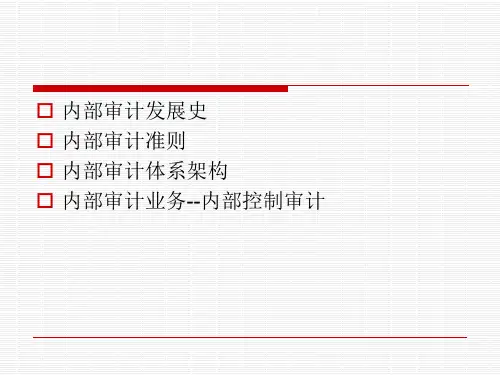
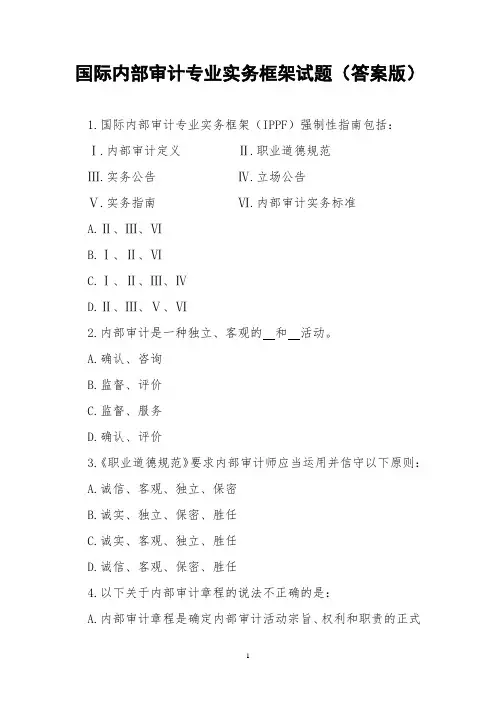
国际内部审计专业实务框架试题(答案版)1.国际内部审计专业实务框架(IPPF)强制性指南包括:Ⅰ.内部审计定义Ⅱ.职业道德规范Ⅲ.实务公告Ⅳ.立场公告Ⅴ.实务指南Ⅵ.内部审计实务标准A.Ⅱ、Ⅲ、ⅥB.Ⅰ、Ⅱ、ⅥC.Ⅰ、Ⅱ、Ⅲ、ⅣD.Ⅱ、Ⅲ、Ⅴ、Ⅵ2.内部审计是一种独立、客观的和活动。
A.确认、咨询B.监督、评价C.监督、服务D.确认、评价3.《职业道德规范》要求内部审计师应当运用并信守以下原则:A.诚信、客观、独立、保密B.诚实、独立、保密、胜任C.诚实、客观、独立、胜任D.诚信、客观、保密、胜任4.以下关于内部审计章程的说法不正确的是:A.内部审计章程是确定内部审计活动宗旨、权利和职责的正式文件。
B.内部审计章程的最终审批权在董事会。
C.向组织提供的确认服务的性质必须在内部审计章程中规定。
D.咨询服务的性质可以不在内部审计章程中规定。
5.以下那种情况表明内部审计师的客观性受到损害:Ⅰ.内部审计师为其在上一年度内负责的业务提供确认服务。
Ⅱ.确认服务涉及首席审计执行官负责的职能领域时,由独立于内部审计部门的某一方进行监督。
Ⅲ.内部审计师对其以往负责的业务提供咨询服务。
Ⅳ.内部审计师可能会损害拟开展的咨询服务的独立性或客观性时,在接受该业务之后向客户进行披露。
A.Ⅰ、ⅢB.Ⅰ、ⅣC.Ⅰ、Ⅲ、ⅣD.Ⅰ、Ⅱ、Ⅲ、Ⅳ6.以下那几项是IPPF对专业能力的要求:Ⅰ.内部审计师缺乏完成全部或部分业务所需的知识、技能或其他能力时,首席审计执行官必须向他人寻求充分的专业建议和协助。
Ⅱ.内部审计师必须充分了解有关评估舞弊风险以及所在组织管理舞弊风险的知识,但不期望所有内部审计师掌握以发现和调查舞弊为首要职能的人员所具备的专门技能。
Ⅲ.所有内部审计师都必须熟练掌握信息技术审计的全部技能。
Ⅳ.当内部审计师缺乏完成全部或部分咨询业务所必需的知识、技能或其他能力时,首席审计执行官必须谢绝开展此项业务。
A.Ⅱ、Ⅲ、ⅣB.Ⅰ、ⅡC.Ⅱ、ⅣD.Ⅰ、Ⅱ、Ⅲ7.为保持应有的职业审慎,内部审计师必须考虑的因素包括:Ⅰ.为实现业务目标而需要开展工作的范围。
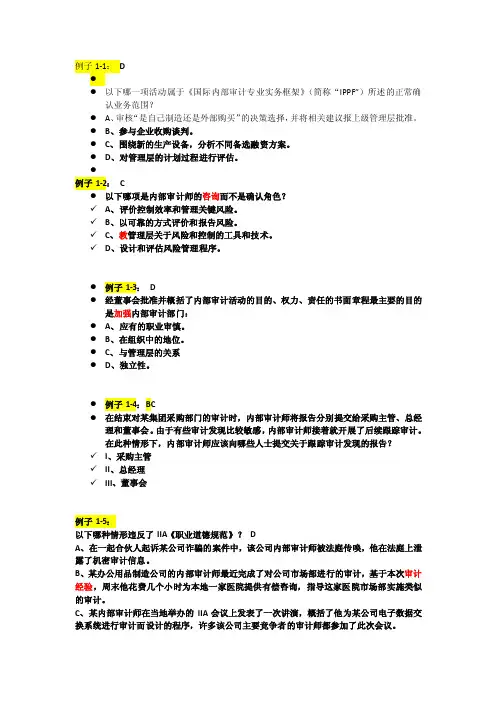
例子1-1: D●●以下哪一项活动属于《国际内部审计专业实务框架》(简称“IPPF”)所述的正常确认业务范围?●A、审核“是自己制造还是外部购买”的决策选择,并将相关建议报上级管理层批准。
●B、参与企业收购谈判。
●C、围绕新的生产设备,分析不同备选融资方案。
●D、对管理层的计划过程进行评估。
●例子1-2: C●以下哪项是内部审计师的咨询而不是确认角色?✓A、评价控制效率和管理关键风险。
✓B、以可靠的方式评价和报告风险。
✓C、教管理层关于风险和控制的工具和技术。
✓D、设计和评估风险管理程序。
●例子1-3: D●经董事会批准并概括了内部审计活动的目的、权力、责任的书面章程最主要的目的是加强内部审计部门:●A、应有的职业审慎。
●B、在组织中的地位。
●C、与管理层的关系●D、独立性。
●例子1-4:BC●在结束对某集团采购部门的审计时,内部审计师将报告分别提交给采购主管、总经理和董事会。
由于有些审计发现比较敏感,内部审计师接着就开展了后续跟踪审计。
在此种情形下,内部审计师应该向哪些人士提交关于跟踪审计发现的报告?✓I、采购主管✓II、总经理✓III、董事会例子1-5:以下哪种情形违反了IIA《职业道德规范》?DA、在一起合伙人起诉某公司诈骗的案件中,该公司内部审计师被法庭传唤,他在法庭上泄露了机密审计信息。
B、某办公用品制造公司的内部审计师最近完成了对公司市场部进行的审计,基于本次审计经验,周末他花费几个小时为本地一家医院提供有偿咨询,指导这家医院市场部实施类似的审计。
C、某内部审计师在当地举办的IIA会议上发表了一次讲演,概括了他为某公司电子数据交换系统进行审计而设计的程序,许多该公司主要竞争者的审计师都参加了此次会议。
D、在一次审计中,内部审计师了解到某公司将要推出一种能使该产业发生变革的新产品,由于新产品可能成功,该内部审计师接受了生产经理的建议,多购入了该公司股票。
例子1-6例子2-1: B在确认是否应将采购部或人事部列入审计日常安排时,以下哪个因素最不重要?A、其中一个部门的经营发生了重大变动?B、最近新来了一个精通其中领域知识的内部审计师。
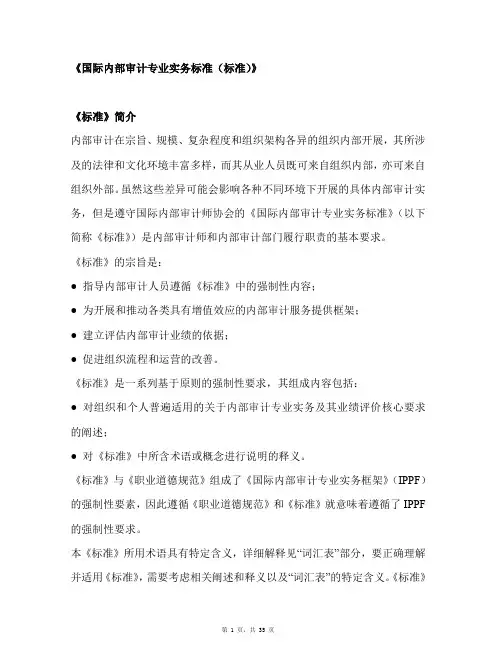
《国际内部审计专业实务标准(标准)》《标准》简介内部审计在宗旨、规模、复杂程度和组织架构各异的组织内部开展,其所涉及的法律和文化环境丰富多样,而其从业人员既可来自组织内部,亦可来自组织外部。
虽然这些差异可能会影响各种不同环境下开展的具体内部审计实务,但是遵守国际内部审计师协会的《国际内部审计专业实务标准》(以下简称《标准》)是内部审计师和内部审计部门履行职责的基本要求。
《标准》的宗旨是:●指导内部审计人员遵循《标准》中的强制性内容;●为开展和推动各类具有增值效应的内部审计服务提供框架;●建立评估内部审计业绩的依据;●促进组织流程和运营的改善。
《标准》是一系列基于原则的强制性要求,其组成内容包括:●对组织和个人普遍适用的关于内部审计专业实务及其业绩评价核心要求的阐述;●对《标准》中所含术语或概念进行说明的释义。
《标准》与《职业道德规范》组成了《国际内部审计专业实务框架》(IPPF)的强制性要素,因此遵循《职业道德规范》和《标准》就意味着遵循了IPPF 的强制性要求。
本《标准》所用术语具有特定含义,详细解释见“词汇表”部分,要正确理解并适用《标准》,需要考虑相关阐述和释义以及“词汇表”的特定含义。
《标准》用“必须”一词来表示无条件的强制性要求,并用“应当”一词来表示期待相关要求得到遵守,除非根据专业判断所涉情形允许偏离《标准》的要求。
《标准》主要由两部分内容组成:属性标准和工作标准。
属性标准说明开展内部审计活动的组织和个人的特征。
工作标准描述内部审计活动的性质,并提供了衡量内部审计活动实施质量的准绳。
属性标准和工作标准适用于所有的内部审计服务。
实施标准是对属性标准和工作标准的扩充,提供适用于确认服务(A)或咨询服务(C)的相关要求。
确认服务指内部审计师为了对机构、运营、职能、流程、系统或其他对象提供意见或结论而作出的客观评价。
确认服务的性质和范围由内部审计师确定。
一般而言,确认服务涉及三方:(1) 与接受确认服务的机构、运营、职能、流程或其他对象存在直接关系的个人或机构,即被审计单位或个人;(2)开展确认服务的个人或机构,即内部审计师;(3)应用确认服务的个人或机构,即用户。
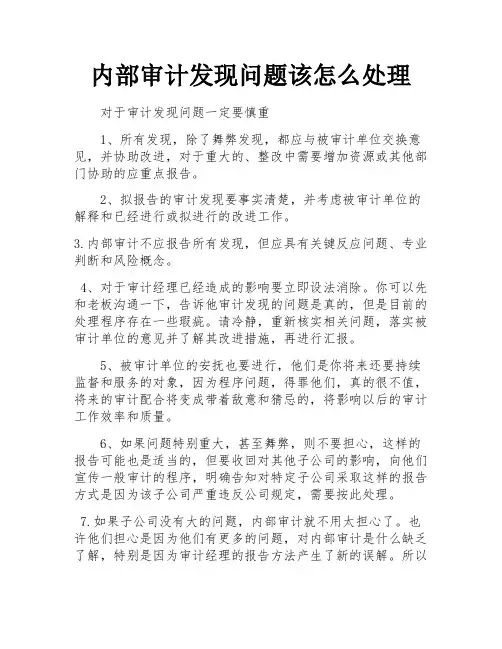
内部审计发现问题该怎么处理对于审计发现问题一定要慎重1、所有发现,除了舞弊发现,都应与被审计单位交换意见,并协助改进,对于重大的、整改中需要增加资源或其他部门协助的应重点报告。
2、拟报告的审计发现要事实清楚,并考虑被审计单位的解释和已经进行或拟进行的改进工作。
3.内部审计不应报告所有发现,但应具有关键反应问题、专业判断和风险概念。
4、对于审计经理已经造成的影响要立即设法消除。
你可以先和老板沟通一下,告诉他审计发现的问题是真的,但是目前的处理程序存在一些瑕疵。
请冷静,重新核实相关问题,落实被审计单位的意见并了解其改进措施,再进行汇报。
5、被审计单位的安抚也要进行,他们是你将来还要持续监督和服务的对象,因为程序问题,得罪他们,真的很不值,将来的审计配合将变成带着敌意和猜忌的,将影响以后的审计工作效率和质量。
6、如果问题特别重大,甚至舞弊,则不要担心,这样的报告可能也是适当的,但要收回对其他子公司的影响,向他们宣传一般审计的程序,明确告知对特定子公司采取这样的报告方式是因为该子公司严重违反公司规定,需要按此处理。
7.如果子公司没有大的问题,内部审计就不用太担心了。
也许他们担心是因为他们有更多的问题,对内部审计是什么缺乏了解,特别是因为审计经理的报告方法产生了新的误解。
所以你也要注意对审计职能定位的宣传,让大家理解和支持内部审计。
8、内审的目的也是规范企业管理,不是来搞某个人,不要把斗争的一套用到企业管理上。
为了自己的利益,损害别人,结果还是搬起石头砸自己。
审计发现的问题如何定性?世界上没有两个完全相同的审计结果。
每个审计结果都代表了一定程度的实际或潜在损失或风险。
因此,内部审计师在向管理层提交审计报告之前,应仔细考虑缺陷可能造成或已经造成损害的程度。
通常,审计发现分为三类:不重要、次要和重要。
1无关紧要的审计发现一项无关紧要的审计发现-例如所有组织都经历过的抄写工作中的笔误,并不能让人觉得需要采取正式的行动。
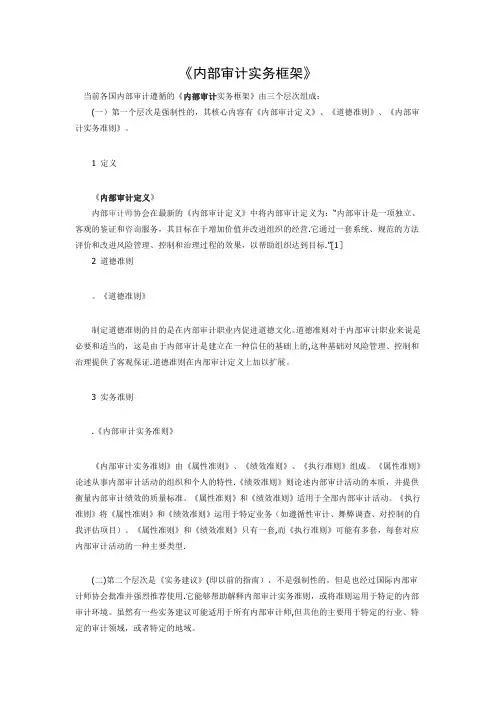
《内部审计实务框架》当前各国内部审计遵循的《内部审计实务框架》由三个层次组成:(一)第一个层次是强制性的,其核心内容有《内部审计定义》、《道德准则》、《内部审计实务准则》。
1 定义《内部审计定义》内部审计师协会在最新的《内部审计定义》中将内部审计定义为:“内部审计是一项独立、客观的鉴证和咨询服务,其目标在于增加价值并改进组织的经营.它通过一套系统、规范的方法评价和改进风险管理、控制和治理过程的效果,以帮助组织达到目标.”[1]2 道德准则。
《道德准则》制定道德准则的目的是在内部审计职业内促进道德文化。
道德准则对于内部审计职业来说是必要和适当的,这是由于内部审计是建立在一种信任的基础上的,这种基础对风险管理、控制和治理提供了客观保证.道德准则在内部审计定义上加以扩展。
3 实务准则.《内部审计实务准则》《内部审计实务准则》由《属性准则》、《绩效准则》、《执行准则》组成。
《属性准则》论述从事内部审计活动的组织和个人的特性.《绩效准则》则论述内部审计活动的本质,并提供衡量内部审计绩效的质量标准。
《属性准则》和《绩效准则》适用于全部内部审计活动。
《执行准则》将《属性准则》和《绩效准则》运用于特定业务(如遵循性审计、舞弊调查、对控制的自我评估项目)。
《属性准则》和《绩效准则》只有一套,而《执行准则》可能有多套,每套对应内部审计活动的一种主要类型.(二)第二个层次是《实务建议》(即以前的指南),不是强制性的,但是也经过国际内部审计师协会批准并强烈推荐使用.它能够帮助解释内部审计实务准则,或将准则运用于特定的内部审计环境。
虽然有一些实务建议可能适用于所有内部审计师,但其他的主要用于特定的行业、特定的审计领域,或者特定的地域。
(三)第三个层次是《发展和实务指南》,包括了各类由国际内部审计师协会开发或者批准的材料,不具有强制性。
其中包括研究报告、书籍、讨论会以及其他还没有资格成为强制性准则的与内部审计实务有关的产品和服务,是审计实务框架中内容最多、最广泛的部分。
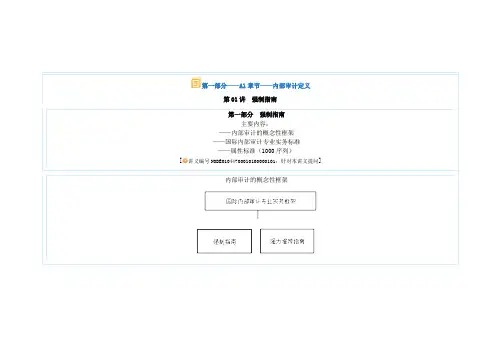
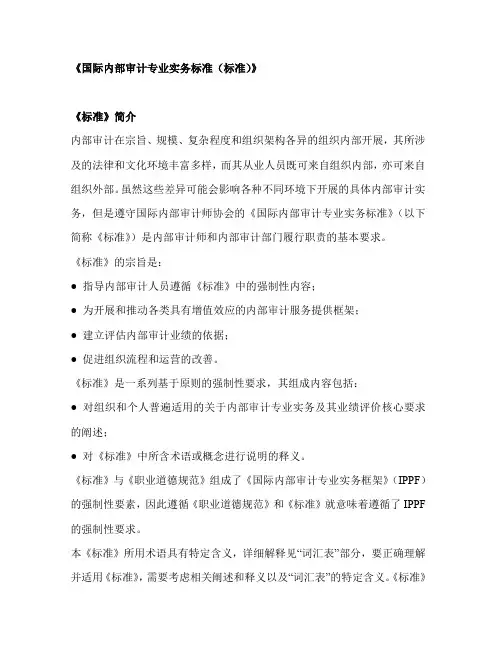
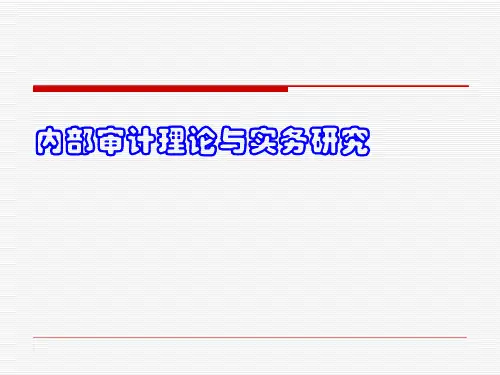
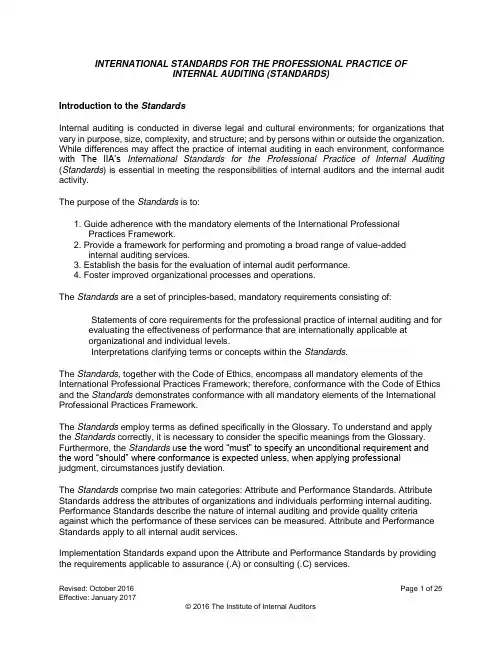
INTERNATIONAL STANDARDS FOR THE PROFESSIONAL PRACTICE OFINTERNAL AUDITING (STANDARDS)Introduction to the StandardsInternal auditing is conducted in diverse legal and cultural environments; for organizations that vary in purpose, size, complexity, and structure; and by persons within or outside the organization. While differences may affect the practice of internal auditing in each environment, conformance with The IIA’s International Standards for the Professional Practice of Internal Auditing (Standards) is essential in meeting the responsibilities of internal auditors and the internal audit activity.The purpose of the Standards is to:1. Guide adherence with the mandatory elements of the International ProfessionalPractices Framework.2. Provide a framework for performing and promoting a broad range of value-addedinternal auditing services.3. Establish the basis for the evaluation of internal audit performance.4. Foster improved organizational processes and operations.The Standards are a set of principles-based, mandatory requirements consisting of: Statements of core requirements for the professional practice of internal auditing and for evaluating the effectiveness of performance that are internationally applicable atorganizational and individual levels.Interpretations clarifying terms or concepts within the Standards.The Standards, together with the Code of Ethics, encompass all mandatory elements of the International Professional Practices Framework; therefore, conformance with the Code of Ethics and the Standards demonstrates conformance with all mandatory elements of the International Professional Practices Framework.The Standards employ terms as defined specifically in the Glossary. To understand and apply the Standards correctly, it is necessary to consider the specific meanings from the Glossary. Furthermore, the Standards u se the word “must” to specify an unconditional requirement and the word “should” where conformance is expected unless, when applying professional judgment, circumstances justify deviation.The Standards comprise two main categories: Attribute and Performance Standards. Attribute Standards address the attributes of organizations and individuals performing internal auditing. Performance Standards describe the nature of internal auditing and provide quality criteria against which the performance of these services can be measured. Attribute and Performance Standards apply to all internal audit services.Implementation Standards expand upon the Attribute and Performance Standards by providing the requirements applicable to assurance (.A) or consulting (.C) services.Revised: October 2016 Page 1 of 25 Effective: January 2017© 2016 The Institute of Internal AuditorsAssurance services involve the internal auditor’s objective assessment of evidence to provide opinions or conclusions regarding an entity, operation, function, process, system, or other subject matters. The nature and scope of an assurance engagement are determined by the internal auditor. Generally, three parties are participants in assurance services: (1) the person or group directly involved with the entity, operation, function, process, system, or other subject matter — the process owner, (2) the person or group making the assessment — the internal auditor, and (3) the person or group using the assessment — the user.Consulting services are advisory in nature and are generally performed at the specific request of an engagement client. The nature and scope of the consulting engagement are subject to agreement with the engagement client. Consulting services generally involve two parties: (1) the person or group offering the advice — the internal auditor, and (2) the person or group seeking and receiving the advice — the engagement client. When performing consulting services the internal auditor should maintain objectivity and not assume management responsibility.The Standards apply to individual internal auditors and the internal audit activity. All internal auditors are accountable for conforming with the standards related to individual objectivity, proficiency, and due professional care and the standards relevant to the performance of their job responsibilities. Chief audit executives are additionally accountable for the internal audit activity’s overall conformance with the Standards.If internal auditors or the internal audit activity is prohibited by law or regulation from conformance with certain parts of the Standards, conformance with all other parts of the Standards and appropriate disclosures are needed.If the Standards are used in conjunction with requirements issued by other authoritative bodies, internal audit communications may also cite the use of other requirements, as appropriate. In such a case, if the internal audit activity indicates conformance with the Standards and inconsistencies exist between the Standards and other requirements, internal auditors and the internal audit activity must conform with the Standards and may conform with the other requirements if such requirements are more restrictive.The review and development of the Standards is an ongoing process. The International Internal Audit Standards Board engages in extensive consultation and discussion before issuing the Standards. This includes worldwide solicitation for public comment through the exposure draft process. All exposure drafts are posted on The IIA’s website as well as being distributed to all IIA institutes.Suggestions and comments regarding the Standards can be sent to:The Institute of Internal AuditorsStandards and Guidance1035 Greenwood Blvd, Suite 401Lake Mary, FL 32746 USAE-mail: Web: ***INTERNATIONAL STANDARDS FOR THE PROFESSIONAL PRACTICE OFINTERNAL AUDITING (STANDARDS)Attribute Standards1000 – Purpose, Authority, and ResponsibilityThe purpose, authority, and responsibility of the internal audit activity must be formally defined in an internal audit charter, consistent with the Mission of Internal Audit and the mandatory elements of the International Professional Practices Framework (the Core Principles for the Professional Practice of Internal Auditing, the Code of Ethics, the Standards, and the Definition of Internal Auditing). The chief audit executive must periodically review the internal audit charter and present it to senior management and the board for approval.Interpretation:The internal audit charter is a formal document that defines the internal audit activity's purpose, authority, and responsibility. The internal audit charter establishes the internal audit activity's position within the organization, including the nature of the chief audit executive’s functional reporting relationship with the board; authorizes access to records, personnel, and physical properties relevant to the performance of engagements; and defines the scope of internal audit activities. Final approval of the internal audit charter resides with the board.1000.A1 –The nature of assurance services provided to the organization must be defined in the internal audit charter. If assurances are to be provided to parties outside the organization, the nature of these assurances must also be defined in the internal audit charter.1000.C1 –The nature of consulting services must be defined in the internal audit charter. 1010 – Recognizing Mandatory Guidance in the Internal Audit CharterThe mandatory nature of the Core Principles for the Professional Practice of Internal Auditing, the Code of Ethics, the Standards, and the Definition of Internal Auditing must be recognized in the internal audit charter. The chief audit executive should discuss the Mission of Internal Audit and the mandatory elements of the International Professional Practices Framework with senior management and the board.1100 – Independence and ObjectivityThe internal audit activity must be independent, and internal auditors must be objective in performing their work.Interpretation:Independence is the freedom from conditions that threaten the ability of the internal audit activity to carry out internal audit responsibilities in an unbiased manner. To achieve the degree of independence necessary to effectively carry out the responsibilities of the internal audit activity, the chief audit executive has direct and unrestricted access to senior management and the board.This can be achieved through a dual-reporting relationship. Threats to independence must be managed at the individual auditor, engagement, functional, and organizational levels.Objectivity is an unbiased mental attitude that allows internal auditors to perform engagements in such a manner that they believe in their work product and that no quality compromises are made. Objectivity requires that internal auditors do not subordinate their judgment on audit matters to others. Threats to objectivity must be managed at the individual auditor, engagement, functional, and organizational levels.1110 – Organizational IndependenceThe chief audit executive must report to a level within the organization that allows the internal audit activity to fulfill its responsibilities. The chief audit executive must confirm to the board, at least annually, the organizational independence of the internal audit activity.Interpretation:Organizational independence is effectively achieved when the chief audit executive reports functionally to the board. Examples of functional reporting to the board involve the board: Approving the internal audit charter.Approving the risk-based internal audit plan.Approving the internal audit budget and resource plan.Receiving communications from the chief audit executive on the internal audit activity’s performance relative to its plan and other matters.Approving decisions regarding the appointment and removal of the chief audit executive.Approving the remuneration of the chief audit executive.Making appropriate inquiries of management and the chief audit executive to determine whether there are inappropriate scope or resource limitations.1110.A1 –The internal audit activity must be free from interference in determining the scope of internal auditing, performing work, and communicating results. The chief audit executive must disclose such interference to the board and discuss the implications.1111 – Direct Interaction with the BoardThe chief audit executive must communicate and interact directly with the board.1112 – Chief Audit Executive Roles Beyond Internal AuditingWhere the chief audit executive has or is expected to have roles and/or responsibilities that fall outside of internal auditing, safeguards must be in place to limit impairments to independence or objectivity.Interpretation:The chief audit executive may be asked to take on additional roles and responsibilities outside of internal auditing, such as responsibility for compliance or risk management activities. These roles and responsibilities may impair, or appear to impair, the organizational independence of theinternal audit activity or the individual objectivity of the internal auditor. Safeguards are those oversight activities, often undertaken by the board, to address these potential impairments, and may include such activities as periodically evaluating reporting lines and responsibilities and developing alternative processes to obtain assurance related to the areas of additional responsibility.1120 – Individual ObjectivityInternal auditors must have an impartial, unbiased attitude and avoid any conflict of interest. Interpretation:Conflict of interest is a situation in which an internal auditor, who is in a position of trust, has a competing professional or personal interest. Such competing interests can make it difficult to fulfill his or her duties impartially. A conflict of interest exists even if no unethical or improper act results.A conflict of interest can create an appearance of impropriety that can undermine confidence in the internal auditor, the internal audit activity, and the profession. A conflict of interest could impair an individual's ability to perform his or her duties and responsibilities objectively.1130 – Impairment to Independence or ObjectivityIf independence or objectivity is impaired in fact or appearance, the details of the impairment must be disclosed to appropriate parties. The nature of the disclosure will depend upon the impairment. Interpretation:Impairment to organizational independence and individual objectivity may include, but is not limited to, personal conflict of interest, scope limitations, restrictions on access to records, personnel, and properties, and resource limitations, such as funding.The determination of appropriate parties to which the details of an impairment to independence or objectivity must be disclosed is dependent upon the expectations of the internal audit activity’s and the chief audit executive’s responsibilities to senior management and the board as described in the internal audit charter, as well as the nature of the impairment.1130.A1 –Internal auditors must refrain from assessing specific operations for which they were previously responsible. Objectivity is presumed to be impaired if an internal auditor provides assurance services for an activity for which the internal auditor had responsibility within the previous year.1130.A2 –Assurance engagements for functions over which the chief audit executive has responsibility must be overseen by a party outside the internal audit activity.1130.A3 –The internal audit activity may provide assurance services where it had previously performed consulting services, provided the nature of the consulting did not impair objectivity and provided individual objectivity is managed when assigning resources to the engagement.1130.C1 –Internal auditors may provide consulting services relating to operations for which they had previous responsibilities.1130.C2 –If internal auditors have potential impairments to independence or objectivity relating to proposed consulting services, disclosure must be made to the engagement client prior to accepting the engagement.1200 – Proficiency and Due Professional CareEngagements must be performed with proficiency and due professional care.1210 – ProficiencyInternal auditors must possess the knowledge, skills, and other competencies needed to perform their individual responsibilities. The internal audit activity collectively must possess or obtain the knowledge, skills, and other competencies needed to perform its responsibilities.Interpretation:Proficiency is a collective term that refers to the knowledge, skills, and other competencies required of internal auditors to effectively carry out their professional responsibilities. It encompasses consideration of current activities, trends, and emerging issues, to enable relevant advice and recommendations. Internal auditors are encouraged to demonstrate their proficiency by obtaining appropriate professional certifications and qualifications, such as the Certified Internal Auditor designation and other designations offered by The Institute of Internal Auditors and other appropriate professional organizations.1210.A1 –The chief audit executive must obtain competent advice and assistance if the internal auditors lack the knowledge, skills, or other competencies needed to perform all or part of the engagement.1210.A2 –Internal auditors must have sufficient knowledge to evaluate the risk of fraud and the manner in which it is managed by the organization, but are not expected to have the expertise of a person whose primary responsibility is detecting and investigating fraud.1210.A3 –Internal auditors must have sufficient knowledge of key information technology risks and controls and available technology-based audit techniques to perform their assigned work. However, not all internal auditors are expected to have the expertise of an internal auditor whose primary responsibility is information technology auditing.1210.C1 –The chief audit executive must decline the consulting engagement or obtain competent advice and assistance if the internal auditors lack the knowledge, skills, or other competencies needed to perform all or part of the engagement.1220 – Due Professional CareInternal auditors must apply the care and skill expected of a reasonably prudent and competent internal auditor. Due professional care does not imply infallibility.1220.A1 –Internal auditors must exercise due professional care by considering the: Extent of work needed to achieve the engagement’s objec tives.Relative complexity, materiality, or significance of matters to which assuranceprocedures are applied.Adequacy and effectiveness of governance, risk management, and control processes.Probability of significant errors, fraud, or noncompliance.Cost of assurance in relation to potential benefits.1220.A2 –In exercising due professional care internal auditors must consider the use of technology-based audit and other data analysis techniques.1220.A3 –Internal auditors must be alert to the significant risks that might affect objectives, operations, or resources. However, assurance procedures alone, even when performed with due professional care, do not guarantee that all significant risks will be i dentified.1220.C1 –Internal auditors must exercise due professional care during a consulting engagement by considering the:Needs and expectations of clients, including the nature, timing, and communication ofengagement results.Relative complexity and extent of work needed to achieve the engagemen t’sobjectives.Cost of the consulting engagement in relation to potential benefits.1230 – Continuing Professional DevelopmentInternal auditors must enhance their knowledge, skills, and other competencies through continuing professional development.1300 – Quality Assurance and Improvement ProgramThe chief audit executive must develop and maintain a quality assurance and improvement program that covers all aspects of the internal audit activity.Interpretation:A quality assurance and improvement program is designed to enable an evaluation of the internal audit activity’s conformance with the Standards and an evaluation of whether internal auditors apply the Code of Ethics. The program also assesses the efficiency and effectiveness of the internal audit activity and identifies opportunities for improvement. The chief audit executive should encourage board oversight in the quality assurance and improvement p rogram.1310 – Requirements of the Quality Assurance and Improvement ProgramThe quality assurance and improvement program must include both internal and external assessments.1311 – Internal AssessmentsInternal assessments must include:Ongoing monitoring of the performance of the internal audit activity.Periodic self-assessments or assessments by other persons within the organization with sufficient knowledge of internal audit practices.Interpretation:Ongoing monitoring is an integral part of the day-to-day supervision, review, and measurement of the internal audit activity. Ongoing monitoring is incorporated into the routine policies and practices used to manage the internal audit activity and uses processes, tools, and information considered necessary to evaluate conformance with the Code of Ethics and the Standards.Periodic assessments are conducted to evaluate conformance with the Code of Ethics and the Standards.Sufficient knowledge of internal audit practices requires at least an understanding of all elements of the International Professional Practices Framework.1312 – External AssessmentsExternal assessments must be conducted at least once every five years by a qualified, independent assessor or assessment team from outside the organization. The chief audit executive must discuss with the board:The form and frequency of external assessment.The qualifications and independence of the external assessor or assessment team,including any potential conflict of interest.Interpretation:External assessments may be accomplished through a full external assessment, or a self- assessment with independent external validation. The external assessor must conclude as to conformance with the Code of Ethics and the Standards; the external assessment may also include operational or strategic comments.A qualified assessor or assessment team demonstrates competence in two areas: the professional practice of internal auditing and the external assessment process. Competence can be demonstrated through a mixture of experience and theoretical learning. Experience gained in organizations of similar size, complexity, sector or industry, and technical issues is more valuable than less relevant experience. In the case of an assessment team, not all members of the team need to have all the competencies; it is the team as a whole that is qualified. The chief audit executive uses professional judgment when assessing whether an assessor or assessment team demonstrates sufficient competence to be qualified.An independent assessor or assessment team means not having either an actual or a perceived conflict of interest and not being a part of, or under the control of, the organization to which the internal audit activity belongs. The chief audit executive should encourage board oversight in the external assessment to reduce perceived or potential conflicts of interest.1320 – Reporting on the Quality Assurance and Improvement ProgramThe chief audit executive must communicate the results of the quality assurance and improvement program to senior management and the board. Disclosure should include: The scope and frequency of both the internal and external assessments.The qualifications and independence of the assessor(s) or assessment team, including potential conflicts of interest.Conclusions ofassessors. Correctiveaction plans.Interpretation:The form, content, and frequency of communicating the results of the quality assurance and improvement program is established through discussions with senior management and the board and considers the responsibilities of the internal audit activity and chief audit executive as contained in the internal audit charter. To demonstrate conformance with the Code of Ethics and the Standards, the results of external and periodic internal assessments are communicated upon completion of such assessments, and the results of ongoing monitoring are communicated at least annually. The results include the assessor’s or assessment team’s evaluation with respect to the degree of conformance.1321 –Use of “Conforms with the International Standards for the Professional Practice of Internal Auditing”Indicating that the internal audit activity conforms with the International Standards for the Professional Practice of Internal Auditing is appropriate only if supported by the results of the quality assurance and improvement program.Interpretation:The internal audit activity conforms with the Code of Ethics and the Standards when it achieves the outcomes described therein. The results of the quality assurance and improvement program include the results of both internal and external assessments. All internal audit activities will have the results of internal assessments. Internal audit activities in existence for at least five years will also have the results of external assessments.1322 – Disclosure of NonconformanceWhen nonconformance with the Code of Ethics or the Standards impacts the overall scope or operation of the internal audit activity, the chief audit executive must disclose the nonconformance and the impact to senior management and the board.Revised: October 2016 Page 9 of 25 Effective: January 2017© 2016 The Institute of Internal AuditorsPerformance Standards2000 – Managing the Internal Audit ActivityThe chief audit executive must effectively manage the internal audit activity to ensure it adds value to the organization.Interpretation:The internal audit activity is effectively managed when:It achieves the purpose and responsibility included in the internal audit charter.It conforms with the Standards.Its individual members conform with the Code of Ethics and the Standards.It considers trends and emerging issues that could impact theorganization.The internal audit activity adds value to the organization and its stakeholders when it considers strategies, objectives, and risks; strives to offer ways to enhance governance, risk management, and control processes; and objectively provides relevant assurance.2010 – PlanningThe chief audit executive must establish a risk-based plan to determine the priorities of the internal audit activity, consistent with the organization’s goals.Interpretation:To develop the risk-based plan, the chief audit executive consults with senior management and the board and obtains an understanding of the organization’s strategies, key business objectives, associated risks, and risk management processes. The chief audit executive must review and adjust the plan, as necessary, in response to changes in the organization’s business, risks, operations, programs, systems, and controls.2010.A1 –The internal audit activity’s plan of engagements must be based on a documented risk assessment, undertaken at least annually. The input of senior management and the board must be considered in this process.2010.A2 – The chief audit executive must identify and consider the expectations of senior management, the board, and other stakeholders for internal audit opinions and other conclusions.2010.C1 –The chief audit executive should consider accepting proposed consulting engagements based on the engagement’s potential to improve management of risks, add value, and improve the organization’s operations. Accepted engagements must be included in the plan.2020 – Communication and ApprovalThe chief audit executive must communicate the internal audit activity’s plans and resource requirements, including significant interim changes, to senior management and the board for review and approval. The chief audit executive must also communicate the impact of resource limitations.2030 – Resource ManagementThe chief audit executive must ensure that internal audit resources are appropriate, sufficient, and effectively deployed to achieve the approved plan.Interpretation:Appropriate refers to the mix of knowledge, skills, and other competencies needed to perform the plan. Sufficient refers to the quantity of resources needed to accomplish the plan. Resources are effectively deployed when they are used in a way that optimizes the achievement of the approved plan.2040 – Policies and ProceduresThe chief audit executive must establish policies and procedures to guide the internal audit activity.Interpretation:The form and content of policies and procedures are dependent upon the size and structure of the internal audit activity and the complexity of its work.2050 – Coordination and RelianceThe chief audit executive should share information, coordinate activities, and consider relying upon the work of other internal and external assurance and consulting service providers to ensure proper coverage and minimize duplication of efforts.Interpretation:In coordinating activities, the chief audit executive may rely on the work of other assurance and consulting service providers. A consistent process for the basis of reliance should be established, and the chief audit executive should consider the competency, objectivity, and due professional care of the assurance and consulting service providers. The chief audit executive should also have a clear understanding of the scope, objectives, and results of the work performed by other providers of assurance and consulting services. Where reliance is placed on the work of others, the chief audit executive is still accountable and responsible for ensuring adequate support for conclusions and opinions reached by the internal audit activity.2060 – Reporting to Senior Management and the BoardThe chief audit executive must report periodically to senior management and the board on the internal audit activity’s purpose, authority, responsibility, and performance relative to its plan and on its conformance with the Code of Ethics and the Standards. Reporting must also include。
国际内部审计师《内部审计基础》巩固练习(2022年4月1日-2022年4月30日)单项选择题1、IPPF通过以下哪种类型的标准扩展了《属性标准》和《工作标准》中适用于确认服务和正确答案:C答案解析a.不正确。
见题解c。
b.不正确。
见题解c。
c.正确。
实施标准是对《属性标准》和《工作标准》的扩充,提供了适用于确认服务(A)或咨询服务(C)的相关要求。
d.不正确。
见题解c。
考察知识点内部审计的确认服务和咨询服务正确答案:A答案解析治理平衡了经济和社会目标,是作用之一。
它上从董事会开始,并且由董事会负责实施。
普通股股东不负责在组织内实施决策。
如果管理团队的成员也是普通股股东,那么他们必须根据其管理职能做出决策,并且必须将其所有者权益与管理职责分开。
组织变革通过变革推动者进行,包括员工和组织的高层管理人员。
外部顾问通常充当变革推动者,因为他们可以提供客观、独立的组织观点。
考察知识点治理正确答案:B答案解析a.不正确。
《执行指南》“1000—宗旨、权力和职责”关于“执行时的考虑因素”建议:CAE 和董事会可以商定审查和重新确认内部审计章程的频率,以确定章程的内容是否仍能推动内部审计部门实现其目标,或者是否需要任何更改。
如果在此期间出现新的问题,可以根据需要援引章程相关条款或进行更新。
可见,经董事会批准的内部审计章程也需要定期审査和更新。
b.正确,根据《标准》1000.A1—向组织提供的确认服务的性质必须在内部审计章程中明确规定。
如果向组织外部的有关方面提供确认服务,则此类确认服务的性质也必须在内部审计章程中确定。
1000.C1—咨询服务的性质必须在内部审计章程中确定。
可见,还应包括咨询服务。
c.不正确。
《标准》“1000—宗旨、权力和职责”的释义中明确:内部审计章程确立了内部审计部门在组织内部的地位,包括CAE与董事会之间职能性报告关系的性质。
d.不正确。
IPPF未要求内部审计章程必须包括CAE的行政性报告关系的性质。
CIA内部审计师-科目1:内部审计基础-高频考点题-01内部审计基本知识[单选题]1.2017版《IPPF》的强制性指南包括哪些内容?I.《标准》II.《职业道德规范》Ⅲ.内部审计定义IV.《执行指南》V.内(江南博哥)部审计实务的核心原则A.I、II、Ⅲ和V正确。
B.只有Ⅱ和V正确。
C.只有Ⅳ正确。
D.I、II、Ⅲ正确。
正确答案:A参考解析:I.正确。
IPPF的强制性指南包括:《内部审计实务的核心原则》、内部审计定义、《职业道德规范》和《标准》。
同理II、Ⅲ、V正确。
IV.不正确。
《执行指南》是IIA推荐性指南的一部分。
[单选题]2.关于IPPF的《补充指南》,哪项陈述是正确的?I.提供了内部审计活动可交付成果的范例。
Ⅱ.列出了可供选择的最佳实务,包括审计方法、原则和行为,内部审计人员可以将这些应用到他们的工作中。
Ⅲ.通过正式的审批程序得到了IIA的推荐和认可。
Ⅳ.属有IIA强制性指南的一部分。
A.只有I和Ⅲ正确。
B.只有Ⅱ正确。
C.只有Ⅳ正确。
D.I、II、Ⅲ正确。
正确答案:D参考解析:I、Ⅱ正确。
这是《补充指南》的价值所在。
III.正确。
《补充指南》是IIA推荐性指南的一部分。
IV.不正确。
《补充指南》是IIA推荐性指南的一部分,而不是强制性指南的一部分。
[单选题]3.现行的2017版IPPF第一部分是:A.《标准》B.《职业道德规范》C.内部审计定义D.《内部审计的使命》正确答案:D参考解析:A.不正确。
强制性指南包括《内部审计实务的核心原则》、内部审计定义、《职业道德规范》和《标准》。
同理b、c不正确。
D.正确。
2017版IPPF包括《内部审计的使命》、强制性指南和推荐性指南。
[单选题]4.关于《内部审计的使命》,以下哪项描述正确?A.以风险为基础,提供客观的确认、建议和洞见,增加和保护组织价值。
B.应用系统的、规范的方法为组织提供的确认和咨询服务。
C.评价并改善风险管理、控制和治理过程的效果。
IIA International Professional Practice Framework(IPPF) 国际部审计专业实务框架(国际部审计师协会2009年1月修订)(红皮书)中国部审计协会译★部审计定义★职业道德规★国际部审计专业实务标准★实务公告修订说明作为整合IIA所发布标准的概念性框架,《国际部审计专业实务框架》的围缩减到只包括由IIA国际技术委员会按照适当程序制定的权威标准。
该权威标准由以下两部分构成:强制性指南。
遵循强制性指南的原则对于部审计专业实务是必须且重要的。
强制性指南的制定遵循既定的尽职审查程序,包括公布征求意见稿,广泛听取各界的意见。
《国际部审计专业实务框架》的三个强制部分为“部审计定义”、《职业道德规》和《国际部审计专业实务标准》(以下简称《标准》)。
强力推荐的指南。
强力推荐的指南是IIA通过正式批准程序认可的,阐述有效执行“部审计定义”、《职业道德规》和《标准》的实务,包括立场公告、实务公告和实务指南。
↓新版IPPF所作的重大改变是:(1)程序改进。
加强了IPPF的各个部分,提高了透明度并确定了权威标准和修订周期。
标准的修订周期目前确定为三年,尽管并非每三年都需要进行修改,IIA 仍致力于确保对标准作全面的审核,并视需要进行修订。
(2)发展与实务帮助。
这一部分不再纳入柜架体系。
它曾经包含了部审计师在工作过程中可能会用到的所有资源(例如培训、出版物和研究报告等)。
由于新版IPPF 的围只包括上述的权威标准,这项容不再适合于新的框架。
(3)释义。
这是新增的对标准中的术语和短语作出的进一步阐释,置于需要加以解释的相关标准条款之下。
(4)实务公告。
这部分容在围上已经缩减为只包括用于实施“部审计定义”,《职业道德规》和《标准》的技术和方法。
原框架中涉及工具及技术方法的容已经移至实务指南部分。
(5)实务指南的立场公告。
这是IPPF新增的容,实务指南侧重于在工具和技术的具体运用方面提供指引,包括详细的流程、程序、方案和步骤(例如每一步所形成的结果的例)。
INTERNATIONAL STANDARDS FOR THE PROFESSIONAL PRACTICE OFINTERNAL AUDITING (STANDARDS)Introduction to the StandardsInternal auditing is conducted in diverse legal and cultural environments; for organizations that vary in purpose, size, complexity, and structure; and by persons within or outside the organization. While differences may affect the practice of internal auditing in each environment, conformance with The IIA’s International Standards for the Professional Practice of Internal Auditing (Standards) is essential in meeting the responsibilities of internal auditors and the internal audit activity.The purpose of the Standards is to:1. Guide adherence with the mandatory elements of the International ProfessionalPractices Framework.2. Provide a framework for performing and promoting a broad range of value-addedinternal auditing services.3. Establish the basis for the evaluation of internal audit performance.4. Foster improved organizational processes and operations.The Standards are a set of principles-based, mandatory requirements consisting of: ∙Statements of core requirements for the professional practice of internal auditing and for evaluating the effectiveness of performance that are internationally applicable atorganizational and individual levels.∙Interpretations clarifying terms or concepts within the Standards.The Standards, together with the Code of Ethics, encompass all mandatory elements of the International Professional Practices Framework; therefore, conformance with the Code of Ethics and the Standards demonstrates conformance with all mandatory elements of the International Professional Practices Framework.The Standards employ terms as defined specifically in the Glossary. To understand and apply the Standards correctly, it is necessary to consider the specific meanings from the Glossary. Furthermore, the Standards use the word “must” to spec ify an unconditional requirement and the word “should” where conformance is expected unless, when applying professional judgment, circumstances justify deviation.The Standards comprise two main categories: Attribute and Performance Standards. Attribute Standards address the attributes of organizations and individuals performing internal auditing. Performance Standards describe the nature of internal auditing and provide quality criteria against which the performance of these services can be measured. Attribute and Performance Standards apply to all internal audit services.Implementation Standards expand upon the Attribute and Performance Standards by providing the requirements applicable to assurance (.A) or consulting (.C) services.Revised: October 2016 Page 1 of 25Assurance services inv olve the internal auditor’s objective assessment of evidence to provide opinions or conclusions regarding an entity, operation, function, process, system, or other subject matters. The nature and scope of an assurance engagement are determined by the internal auditor. Generally, three parties are participants in assurance services: (1) the person or group directly involved with the entity, operation, function, process, system, or other subject matter — the process owner, (2) the person or group making the assessment — the internal auditor, and (3) the person or group using the assessment — the user.Consulting services are advisory in nature and are generally performed at the specific request of an engagement client. The nature and scope of the consulting engagement are subject to agreement with the engagement client. Consulting services generally involve two parties: (1) the person or group offering the advice — the internal auditor, and (2) the person or group seeking and receiving the advice — the engagement client. When performing consulting services the internal auditor should maintain objectivity and not assume management responsibility.The Standards apply to individual internal auditors and the internal audit activity. All internal auditors are accountable for conforming with the standards related to individual objectivity, proficiency, and due professional care and the standards relevant to the performance of their job responsibilities. Chief audit executives are additionally accountable for the internal audit activity’s overall conformance with the Standards.If internal auditors or the internal audit activity is prohibited by law or regulation from conformance with certain parts of the Standards, conformance with all other parts of the Standards and appropriate disclosures are needed.If the Standards are used in conjunction with requirements issued by other authoritative bodies, internal audit communications may also cite the use of other requirements, as appropriate. In such a case, if the internal audit activity indicates conformance with the Standards and inconsistencies exist between the Standards and other requirements, internal auditors and the internal audit activity must conform with the Standards and may conform with the other requirements if such requirements are more restrictive.The review and development of the Standards is an ongoing process. The International Internal Audit Standards Board engages in extensive consultation and discussion before issuing the Standards. This includes worldwide solicitation for public comment through the exposure draft process. All exposure drafts are posted on The IIA’s website as well as being distributed to all IIA institutes.Suggestions and comments regarding the Standards can be sent to:The Institute of Internal AuditorsStandards and Guidance1035 Greenwood Blvd, Suite 401Lake Mary, FL 32746 USAE-mail: guidance@ Web: ***INTERNATIONAL STANDARDS FOR THE PROFESSIONAL PRACTICE OFINTERNAL AUDITING (STANDARDS)Attribute Standards1000 – Purpose, Authority, and ResponsibilityThe purpose, authority, and responsibility of the internal audit activity must be formally defined in an internal audit charter, consistent with the Mission of Internal Audit and the mandatory elements of the International Professional Practices Framework (the Core Principles for the Professional Practice of Internal Auditing, the Code of Ethics, the Standards, and the Definition of Internal Auditing). The chief audit executive must periodically review the internal audit charter and present it to senior management and the board for approval.Interpretation:The internal audit charter is a formal document that defines the internal audit activity's purpose, authority, and responsibility. The internal audit charter establishes the internal audit activity's position within the organization, including the nature of the chief audit executive’s functional reporting relationship with the board;authorizes access to records, personnel, and physical properties relevant to the performance of engagements; and defines the scope of internal audit activities. Final approval of the internal audit charter resides with the board.1000.A1 – The nature of assurance services provided to the organization must be defined in the internal audit charter. If assurances are to be provided to parties outside the organization, the nature of these assurances must also be defined in the internal audit charter.1000.C1 – The nature of consulting services must be defined in the internal audit charter. 1010 – Recognizing Mandatory Guidance in the Internal Audit CharterThe mandatory nature of the Core Principles for the Professional Practice of Internal Auditing, the Code of Ethics, the Standards, and the Definition of Internal Auditing must be recognized in the internal audit charter. The chief audit executive should discuss the Mission of Internal Audit and the mandatory elements of the International Professional Practices Framework with senior management and the board.1100 – Independence and ObjectivityThe internal audit activity must be independent, and internal auditors must be objective in performing their work.Interpretation:Independence is the freedom from conditions that threaten the ability of the internal audit activity to carry out internal audit responsibilities in an unbiased manner. To achieve the degree of independence necessary to effectively carry out the responsibilities of the internal audit activity, the chief audit executive has direct and unrestricted access to senior management and the board.This can be achieved through a dual-reporting relationship. Threats to independence must be managed at the individual auditor, engagement, functional, and organizational levels.Objectivity is an unbiased mental attitude that allows internal auditors to perform engagements in such a manner that they believe in their work product and that no quality compromises are made. Objectivity requires that internal auditors do not subordinate their judgment on audit matters to others. Threats to objectivity must be managed at the individual auditor, engagement, functional, and organizational levels.1110 – Organizational IndependenceThe chief audit executive must report to a level within the organization that allows the internal audit activity to fulfill its responsibilities. The chief audit executive must confirm to the board, at least annually, the organizational independence of the internal audit activity.Interpretation:Organizational independence is effectively achieved when the chief audit executive reports functionally to the board. Examples of functional reporting to the board involve the board: ∙Approving the internal audit charter.∙Approving the risk-based internal audit plan.∙Approving the internal audit budget and resource plan.∙Receiving communications from the chief audit executive on the internal audit activity’s performance relative to its plan and other matters.∙Approving decisions regarding the appointment and removal of the chief audit executive.∙Approving the remuneration of the chief audit executive.∙Making appropriate inquiries of management and the chief audit executive to determine whether there are inappropriate scope or resource limitations.1110.A1 – The internal audit activity must be free from interference in determining the scope of internal auditing, performing work, and communicating results. The chief audit executive must disclose such interference to the board and discuss the implications.1111 – Direct Interaction with the BoardThe chief audit executive must communicate and interact directly with the board.1112 – Chief Audit Executive Roles Beyond Internal AuditingWhere the chief audit executive has or is expected to have roles and/or responsibilities that fall outside of internal auditing, safeguards must be in place to limit impairments to independence or objectivity.Interpretation:The chief audit executive may be asked to take on additional roles and responsibilities outside of internal auditing, such as responsibility for compliance or risk management activities. These roles and responsibilities may impair, or appear to impair, the organizational independence of theinternal audit activity or the individual objectivity of the internal auditor. Safeguards are those oversight activities, often undertaken by the board, to address these potential impairments, and may include such activities as periodically evaluating reporting lines and responsibilities and developing alternative processes to obtain assurance related to the areas of additional responsibility.1120 – Individual ObjectivityInternal auditors must have an impartial, unbiased attitude and avoid any conflict of interest. Interpretation:Conflict of interest is a situation in which an internal auditor, who is in a position of trust, has a competing professional or personal interest. Such competing interests can make it difficult to fulfill his or her duties impartially. A conflict of interest exists even if no unethical or improper act results.A conflict of interest can create an appearance of impropriety that can undermine confidence in the internal auditor, the internal audit activity, and the profession. A conflict of interest could impair an individual's ability to perform his or her duties and responsibilities objectively.1130 – Impairment to Independence or ObjectivityIf independence or objectivity is impaired in fact or appearance, the details of the impairment must be disclosed to appropriate parties. The nature of the disclosure will depend upon the impairment. Interpretation:Impairment to organizational independence and individual objectivity may include, but is not limited to, personal conflict of interest, scope limitations, restrictions on access to records, personnel, and properties, and resource limitations, such as funding.The determination of appropriate parties to which the details of an impairment to independence or objectivity must be disclosed is dependent upon the expectations of the internal audit activity’s and the chief audit executive’s responsibilities to senior management and the board as described in the internal audit charter, as well as the nature of the impairment.1130.A1 – Internal auditors must refrain from assessing specific operations for which they were previously responsible. Objectivity is presumed to be impaired if an internal auditor provides assurance services for an activity for which the internal auditor had responsibility within the previous year.1130.A2 – Assurance engagements for functions over which the chief audit executive has responsibility must be overseen by a party outside the internal audit activity.1130.A3 –The internal audit activity may provide assurance services where it had previously performed consulting services, provided the nature of the consulting did not impair objectivity and provided individual objectivity is managed when assigning resources to the engagement.1130.C1– Internal auditors may provide consulting services relating to operations for which they had previous responsibilities.1130.C2–If internal auditors have potential impairments to independence or objectivity relating to proposed consulting services, disclosure must be made to the engagement client prior to accepting the engagement.1200 – Proficiency and Due Professional CareEngagements must be performed with proficiency and due professional care.1210 – ProficiencyInternal auditors must possess the knowledge, skills, and other competencies needed to perform their individual responsibilities. The internal audit activity collectively must possess or obtain the knowledge, skills, and other competencies needed to perform its responsibilities.Interpretation:Proficiency is a collective term that refers to the knowledge, skills, and other competencies required of internal auditors to effectively carry out their professional responsibilities. It encompasses consideration of current activities, trends, and emerging issues, to enable relevant advice and recommendations. Internal auditors are encouraged to demonstrate their proficiency by obtaining appropriate professional certifications and qualifications, such as the Certified Internal Auditor designation and other designations offered by The Institute of Internal Auditors and other appropriate professional organizations.1210.A1–The chief audit executive must obtain competent advice and assistance if the internal auditors lack the knowledge, skills, or other competencies needed to perform all or part of the engagement.1210.A2 –Internal auditors must have sufficient knowledge to evaluate the risk of fraud and the manner in which it is managed by the organization, but are not expected to have the expertise of a person whose primary responsibility is detecting and investigating fraud.1210.A3–Internal auditors must have sufficient knowledge of key information technology risks and controls and available technology-based audit techniques to perform their assigned work. However, not all internal auditors are expected to have the expertise of an internal auditor whose primary responsibility is information technology auditing.1210.C1 –The chief audit executive must decline the consulting engagement or obtain competent advice and assistance if the internal auditors lack the knowledge, skills, or other competencies needed to perform all or part of the engagement.1220 – Due Professional CareInternal auditors must apply the care and skill expected of a reasonably prudent and competent internal auditor. Due professional care does not imply infallibility.1220.A1– Internal auditors must exercise due professional care by considering the: ∙Extent of work needed to achieve the engagement’s objectives.∙Relative complexity, materiality, or significance of matters to which assurance procedures are applied.∙Adequacy and effectiveness of governance, risk management, and control processes.∙Probability of significant errors, fraud, or noncompliance.∙Cost of assurance in relation to potential benefits.1220.A2–In exercising due professional care internal auditors must consider the use of technology-based audit and other data analysis techniques.1220.A3– Internal auditors must be alert to the significant risks that might affect objectives, operations, or resources. However, assurance procedures alone, even when performed with due professional care, do not guarantee that all significant risks will be identified.1220.C1–Internal auditors must exercise due professional care during a consulting engagement by considering the:∙Needs and expectations of clients, including the nature, timing, and communication of engagement results.∙Relative complexity and extent of work needed to achieve the engagement’s objectives.∙Cost of the consulting engagement in relation to potential benefits.1230 – Continuing Professional DevelopmentInternal auditors must enhance their knowledge, skills, and other competencies through continuing professional development.1300 – Quality Assurance and Improvement ProgramThe chief audit executive must develop and maintain a quality assurance and improvement program that covers all aspects of the internal audit activity.Interpretation:A quality assurance and improvement program is designed to enable an evaluation of the internal audit activity’s conformance with the Standards and an evaluation of whether internal auditors apply the Code of Ethics. The program also assesses the efficiency and effectiveness of the internal audit activity and identifies opportunities for improvement. The chief audit executive should encourage board oversight in the quality assurance and improvement program.1310 – Requirements of the Quality Assurance and Improvement ProgramThe quality assurance and improvement program must include both internal and external assessments.1311 – Internal AssessmentsInternal assessments must include:∙Ongoing monitoring of the performance of the internal audit activity.∙Periodic self-assessments or assessments by other persons within the organization with sufficient knowledge of internal audit practices.Interpretation:Ongoing monitoring is an integral part of the day-to-day supervision, review, and measurement of the internal audit activity. Ongoing monitoring is incorporated into the routine policies and practices used to manage the internal audit activity and uses processes, tools, and information considered necessary to evaluate conformance with the Code of Ethics and the Standards.Periodic assessments are conducted to evaluate conformance with the Code of Ethics and the Standards.Sufficient knowledge of internal audit practices requires at least an understanding of all elements of the International Professional Practices Framework.1312 – External AssessmentsExternal assessments must be conducted at least once every five years by a qualified, independent assessor or assessment team from outside the organization. The chief audit executive must discuss with the board:∙The form and frequency of external assessment.∙The qualifications and independence of the external assessor or assessment team, including any potential conflict of interest.Interpretation:External assessments may be accomplished through a full external assessment, or a self-assessment with independent external validation. The external assessor must conclude as to conformance with the Code of Ethics and the Standards; the external assessment may also include operational or strategic comments.A qualified assessor or assessment team demonstrates competence in two areas: the professional practice of internal auditing and the external assessment process. Competence can be demonstrated through a mixture of experience and theoretical learning. Experience gained in organizations of similar size, complexity, sector or industry, and technical issues is more valuable than less relevant experience. In the case of an assessment team, not all members of the team need to have all the competencies; it is the team as a whole that is qualified. The chief audit executive uses professional judgment when assessing whether an assessor or assessment team demonstrates sufficient competence to be qualified.An independent assessor or assessment team means not having either an actual or a perceived conflict of interest and not being a part of, or under the control of, the organization to which the internal audit activity belongs. The chief audit executive should encourage board oversight in the external assessment to reduce perceived or potential conflicts of interest.1320 – Reporting on the Quality Assurance and Improvement ProgramThe chief audit executive must communicate the results of the quality assurance and improvement program to senior management and the board. Disclosure should include: ∙The scope and frequency of both the internal and external assessments.∙The qualifications and independence of the assessor(s) or assessment team, including potential conflicts of interest.∙Conclusions of assessors.∙Corrective action plans.Interpretation:The form, content, and frequency of communicating the results of the quality assurance and improvement program is established through discussions with senior management and the board and considers the responsibilities of the internal audit activity and chief audit executive as contained in the internal audit charter. To demonstrate conformance with the Code of Ethics and the Standards, the results of external and periodic internal assessments are communicated upon completion of such assessments, and the results of ongoing monitoring are communicated at least annually. The results include the assessor’s or assessment team’s evaluation with respect to the degree of conformance.1321 –Use of “Conforms with the International Standards for the Professional Practice of Internal Auditing”Indicating that the internal audit activity conforms with the International Standards for the Professional Practice of Internal Auditing is appropriate only if supported by the results of the quality assurance and improvement program.Interpretation:The internal audit activity conforms with the Code of Ethics and the Standards when it achieves the outcomes described therein. The results of the quality assurance and improvement program include the results of both internal and external assessments. All internal audit activities will have the results of internal assessments. Internal audit activities in existence for at least five years will also have the results of external assessments.1322 – Disclosure of NonconformanceWhen nonconformance with the Code of Ethics or the Standards impacts the overall scope or operation of the internal audit activity, the chief audit executive must disclose the nonconformance and the impact to senior management and the board.Performance Standards2000 – Managing the Internal Audit ActivityThe chief audit executive must effectively manage the internal audit activity to ensure it adds value to the organization.Interpretation:The internal audit activity is effectively managed when:∙It achieves the purpose and responsibility included in the internal audit charter.∙It conforms with the Standards.∙Its individual members conform with the Code of Ethics and the Standards.∙It considers trends and emerging issues that could impact the organization.The internal audit activity adds value to the organization and its stakeholders when it considers strategies, objectives, and risks; strives to offer ways to enhance governance, risk management, and control processes; and objectively provides relevant assurance.2010 – PlanningThe chief audit executive must establish a risk-based plan to determine the priorities of the internal audit activity, consistent with the organization’s goals.Interpretation:To develop the risk-based plan, the chief audit executive consults with senior management and the board and obtains an understanding of the organization’s strategies, key business objectives, associated risks, and risk management processes. The chief audit executive must review and adjust the plan, as necessary, in response to changes in the organization’s business, risks, operations, programs, systems, and controls.2010.A1–The internal audit activity’s plan of engagements must be based on a documented risk assessment, undertaken at least annually. The input of senior management and the board must be considered in this process.2010.A2– The chief audit executive must identify and consider the expectations of senior management, the board, and other stakeholders for internal audit opinions and other conclusions.2010.C1–The chief audit executive should consider accepting proposed consulting engagements based on the engagement’s potential to improve management of risks, add value, and improve the organization’s operations. Accepted engagements must be included in the plan.2020 – Communication and ApprovalThe chief audit executive must communicate the internal audit activity’s plans and resource requirements, including significant interim changes, to senior management and the board for review and approval. The chief audit executive must also communicate the impact of resource limitations.2030 – Resource ManagementThe chief audit executive must ensure that internal audit resources are appropriate, sufficient, and effectively deployed to achieve the approved plan.Interpretation:Appropriate refers to the mix of knowledge, skills, and other competencies needed to perform the plan. Sufficient refers to the quantity of resources needed to accomplish the plan. Resources are effectively deployed when they are used in a way that optimizes the achievement of the approved plan.2040 – Policies and ProceduresThe chief audit executive must establish policies and procedures to guide the internal audit activity.Interpretation:The form and content of policies and procedures are dependent upon the size and structure of the internal audit activity and the complexity of its work.2050 – Coordination and RelianceThe chief audit executive should share information, coordinate activities, and consider relying upon the work of other internal and external assurance and consulting service providers to ensure proper coverage and minimize duplication of efforts.Interpretation:In coordinating activities, the chief audit executive may rely on the work of other assurance and consulting service providers. A consistent process for the basis of reliance should be established, and the chief audit executive should consider the competency, objectivity, and due professional care of the assurance and consulting service providers. The chief audit executive should also have a clear understanding of the scope, objectives, and results of the work performed by other providers of assurance and consulting services. Where reliance is placed on the work of others, the chief audit executive is still accountable and responsible for ensuring adequate support for conclusions and opinions reached by the internal audit activity.2060 – Reporting to Senior Management and the BoardThe chief audit executive must report periodically to senior management and the board on the internal audit activity’s purpose, authority, responsibility, and performance relative to its plan and on its conformance with the Code of Ethics and the Standards. Reporting must also include。